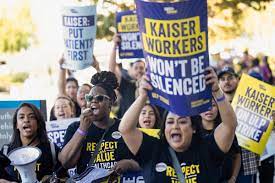Xu Ying
Seismic rumblings of labor strikes are shaking the foundations of the US economy. Tens of thousands of workers are walking out at health care giant such as Kaiser Permanente and auto manufacturers such as General Motors. These strikes represent tremors of a larger social earthquake as pandemic strains, inequality, and soaring costs of living push America’s working class to a breaking point. This revolt encapsulates widening fissures in the social contract after decades of working families struggling with stagnant wages and shrinking benefits.
Workers in health care and manufacturing endured immense risks and challenges through the COVID-19 pandemic. Nurses and technicians worked grueling hours caring for critically ill patients while factories continued churning out products, often without adequate protection. These sectors absorbed the hardest blows but saw minimal relief after the crisis ebbed.
Now, patience has worn thin. Kaiser nurses accuse the giant HMO of worsening under-staffing, overwork, and burnout by denying wage and benefit improvements. Auto workers endured relentless schedules to keep assembly lines running despite supply snags and infection outbreaks. But auto firms such as GM initially offered raises of just 4 percent despite 2021 profits nearing $10 billion. Employees believe they deserve a far greater share after risking their lives while executives enriched shareholders.
These flashpoints reflect simmering frustrations coming to a boil after the pandemic put essential workers under intense strain. But instead of relief, employees face soaring living costs as inflation hits a 40-year high. For workers barely getting by after decades of flat pay, the yawning gap between their sacrifices and corporate windfalls has become a catalyst for revolt.
Today’s strikes signify deep disillusionment with an American economic system that has failed working families. Globalization and financialization over the last 40 years enriched elites while workers faced eroding job security and bargaining power. Regular people watched major crises consistently impact their livelihoods disproportionately as elites prospered. Trust in institutions such as government, business, and media deteriorated as the social contract frayed. Workers grew frustrated with an economy serving the few at the top at the expense of the many toiling below. Demands grew for structural changes to restore fairness, opportunity, and balance.
Labor advocates argue policy shifts must empower unions, elevate wages, strengthen social safety nets, and check corporate influence over government. Workers aim to recast an imbalanced capitalist system that has catered to enriching executives and shareholders above all else. The strikes embody demands for redistributing economic power and prosperity more equitably.
The strikes carry major reverberations since health care and auto manufacturing are linchpins of the economy. With a $4 trillion health care sector and iconic American brands such as GM and Ford, work stoppages in these immense industries send tremors through the whole economic system. Kaiser and the automakers now weigh the risks of operational paralysis against meeting worker demands. But historically, capitalists strongly resist concessions that empower unions and erode profit margins. The choice of confrontation versus compromise has high stakes for charting the country’s course.
If met with obstinacy, today’s strikes could escalate into a cycle of radicalism and grassroots mobilization like during the 1930s New Deal era. Failure to remedy foundational inequalities and power imbalances risks further fraying social cohesion as economic tumult builds. With the economy teetering and inequality reaching new extremes, America has arrived at a pivotal juncture. The pandemic fueled simmering discontents among workers watching corporate profits soar as their wages stagnated and expenses skyrocketed. Now, labor aims to correct the imbalance through flexing its disruptive power.
The choices ahead weigh heavy with history. America today mirrors the Gilded Age’s yawning divides and worker disaffection. Lessons from past crossroads reveal reforming a strained social contract before its total rupture is the wise path forward. The eruption of strikes in 2023 encapsulates widening fissures in the American social contract. Pandemic strains fused with decades of inequality have primed dramatic labor revolt aimed at securing an equitable stake in society. This uprising carries profound stakes for the nation’s future trajectory.







